In Q2 of 2023, a lack of specialists was cited as the top factor hindering business (59% of surveyed companies cited this factor as the most hindering), - according to the report published by the BAG Index.
From a sector-by-sector view, this factor was most frequently pointed out in the service sector (76%), while it was considered the least hindering for the manufacturing sector (33%). In terms of the size of the enterprise, a lack of specialists was most cited by large enterprises as a factor hindering business activity (64% of surveyed large companies cited this factor as hindering).
In Q2 of 2023, volatility of the national currency exchange rate was cited as a hindering factor by 48% of surveyed companies. This issue was felt most acutely in the manufacturing sector (83%), while it was less of a hindrance for the service sector (34%). The volatility of the national currency exchange rate was considered the most problematic for medium enterprises (cited by 53% of them as a hindering factor).
In Q2 of 2023, legal and administrative barriers were cited as a hindering factor by 46% of surveyed companies. This issue was felt most acutely in the trade sector (57%), while it was less of a hindrance for the manufacturing sector (17%). Legal and administrative barriers were considered the most problematic for large enterprises (cited by 60% of them as a hindering factor).
In Q2 of 2023, labor shortage was cited as a hindering factor by 41% of surveyed companies. Across the covered sectors, this factor was deemed the most hindering for the manufacturing sector (57%). In Q2 of 2023, labor shortage was considered the most problematic for large enterprises (cited by 60% of them as a hindering factor).
In Q2 of 2023, financial constraints were cited as a hindering factor by 13% of surveyed companies. This issue was felt most acutely in the manufacturing sector (50%). Financial constraints were considered the most problematic for large enterprises (cited by 16% of them as a hindering factor).
















